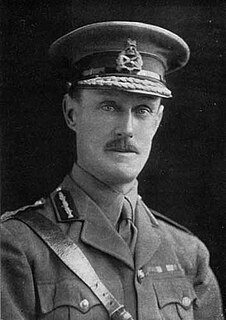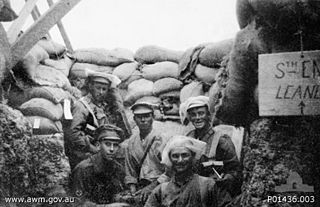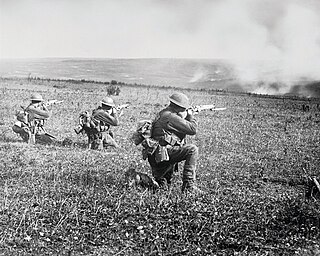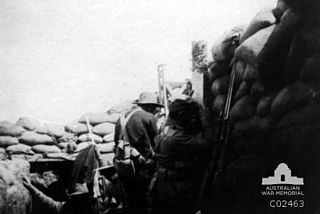Related Research Articles

The First Australian Imperial Force was the main expeditionary force of the Australian Army during World War I. It was formed as the Australian Imperial Force on 15 August 1914, following Britain's declaration of war on Germany, initially with a strength of one infantry division and one light horse brigade. The infantry division subsequently fought at Gallipoli between April and December 1915, being reinforced by a second division which was later raised, as well as three light horse brigades. After being evacuated to Egypt the AIF was expanded to five infantry divisions, which were committed to the fighting in France and Belgium along the Western Front in March 1916. A sixth infantry division was partially raised in 1917 in the United Kingdom, but was broken up and used as reinforcements following heavy casualties on the Western Front. Meanwhile, two mounted divisions remained in the Middle East to fight against Turkish forces in the Sinai and Palestine.

The 3rd Division was an infantry division of the Australian Army. Existing during various periods between 1916 and 1991, it is considered the "longest serving Australian Army division". It was first formed during World War I, as an infantry division of the Australian Imperial Force and saw service on the Western Front in France and Belgium. During this time it fought major battles at Messines, Broodseinde Ridge, Passchendaele, Amiens, and the St Quentin Canal.

The 1st Division is the main formation of the Australian Army and contains the majority of the Army's regular forces. Its headquarters is in Enoggera, a suburb of Brisbane. The division was first formed in 1914 for service during World War I as a part of the Australian Imperial Force (AIF). It was initially part of the Australian and New Zealand Army Corps (ANZAC) and served with that formation during the Gallipoli campaign, before later serving on the Western Front. After the war, the division became a part-time unit based in New South Wales, and during World War II it undertook defensive duties in Australia before being disbanded in 1945.

The 9th Battalion, Royal Queensland Regiment is a Reserve light infantry battalion of the Australian Army, raised and based in the state of Queensland. It is part of the Royal Queensland Regiment and is currently attached to the 11th Brigade of the 2nd Division. 9 RQR can trace its history as far back as 1867 with the establishment Queensland Volunteer Rifle Corps, although it was not until 1911 that it was designated as the "9th Battalion". Over the course of its history, the battalion has served Australia in a number of conflicts including The Boer War, World War I and World War II, while more recently, members of the battalion have been involved in various peacekeeping operations and exercises around the Pacific region.

The 3rd Brigade is a combined arms brigade of the Australian Army, principally made up of the 1st and 3rd Battalions of the Royal Australian Regiment. Initially raised in 1903 as part of the post-Federation Australian Army, it was removed from the order of battle in 1906 following the restructure of the field force. It was re-formed in 1914 for service during World War I, taking part in the fighting at Gallipoli and on the Western Front in Europe. During World War II the brigade was used in a defensive role before it was disbanded in 1944. It was re-raised in 1967 for service during the Vietnam War and later went on to provide the nucleus of the deployment to East Timor during the Australian-led intervention in 1999. The brigade is currently based at Lavarack Barracks in Townsville, Queensland.

General Sir Alexander John Godley, was a senior British Army officer. He is best known for his role as commander of the New Zealand Expeditionary Force and II Anzac Corps during the First World War.

The 12th Battalion was an infantry battalion originally raised for the First Australian Imperial Force during the First World War. The battalion was recruited from Tasmania, South Australia and Western Australia and formed part of the 3rd Brigade, 1st Division. It served throughout the war, firstly during the Gallipoli Campaign and then on the Western Front. During the interwar years, the 12th Battalion was re-raised as a part-time military unit and during the Second World War undertook garrison duties in Australia, but did not see combat. Today its lineage is perpetuated by the 12th/40th Battalion, Royal Tasmania Regiment, a unit which continues to serve in the Australian Army Reserve.

The 16th Battalion, Royal Western Australia Regiment is an Australian Army reserve infantry battalion located in Western Australia and one of the two battalions of the Royal Western Australia Regiment. The battalion was first formed during the First World War, during which it fought during the Gallipoli Campaign and on the Western Front in France and Belgium as part of the Australian Imperial Force. It was re-formed as a part-time unit in Western Australia during the inter-war years, and served in the New Britain Campaign against the Japanese during the Second World War. In the post war years, the battalion became part of the Royal Western Australia Regiment and currently forms part of the 13th Brigade.

The 11th Brigade is an Australian Army brigade which currently comprises most Australian Army Reserve units located in Queensland. The brigade was first formed in early 1912 following the introduction of the compulsory training scheme. Later, as part of the 3rd Division and saw action during World War I on the Western Front as part of the First Australian Imperial Force. In the interwar years, the brigade was re-raised with its headquarters in Brisbane. During World War II, it undertook garrison and defensive duties in north Queensland before deploying to Dutch New Guinea in 1943. In 1944–1945, the brigade took part in the fighting against the Japanese on Bougainville. In the postwar era, the 11th Brigade was raised and disbanded several times, before being raised in Townsville in 1987, where its headquarters is currently located. It forms part of the 2nd Division, and consists of units based across Queensland and New South Wales.

5th Brigade is a brigade of the Australian Army. Originally raised as a militia formation in 1912, the 5th Brigade was re-raised for overseas service in 1915 as part of the Australian Imperial Force during the First World War. The brigade then served during the Gallipoli Campaign and on the Western Front. During the inter-war years, it was re-raised as a part-time formation as part of Citizens Military Force. It undertook garrison duties in Australia during the Second World War, but was not deployed overseas before being disbanded in 1944. Following the war, the brigade was re-raised in 1948 once again and it is currently a Reserve combined arms formation based in New South Wales and forms part of the 2nd Division.

The 32nd Battalion was an infantry battalion of the Australian Army. It was first raised in 1915 as part of the all-volunteer Australian Imperial Force for service during the First World War, and was initially made up of personnel from South Australia and Western Australia. The battalion served in France and Belgium in 1916–1918 before being disbanded in 1919.
The 2nd Brigade was a brigade-sized infantry unit of the Australian Army. Formed in 1903 as a militia formation based in Victoria, the brigade later served during the First World War as part of the Australian Imperial Force, allocated to the 1st Division. During the war, the 2nd Brigade took part in the fighting at Gallipoli, including the Battle of Krithia where it lost almost a third of its strength. Later they took part in the Battle of Lone Pine before being withdrawn back to Egypt in December 1915. Following this the brigade was transferred to the Western Front in France and Belgium where, between March 1916 and the armistice in November 1918, they took part in most of the major Allied operations.

The 12th Brigade was an infantry brigade of the Australian Army. Formed in 1912 as a Militia formation, it was later re-raised in 1916 as part of the all volunteer First Australian Imperial Force that was raised for overseas service during the First World War. The brigade was part of the 4th Division and fought on the Western Front until the end of the war in November 1918. During the inter-war years, the brigade was re-formed in Australia as a part-time unit; during the Second World War, it was mobilised for full-time service, but did not serve overseas, undertaking garrison duties in Australia until 1945 when it was used to raise Timor Force.

The 21st Battalion was an infantry battalion of the Australian Army. It was raised in 1915 as part of the First Australian Imperial Force for service during World War I and formed part of the 6th Brigade, attached to the 2nd Division. It fought during the Gallipoli campaign and on the Western Front before being disbanded in late 1918. The battalion was the first Australian battalion to commence active operations on the Western Front and also had the distinction of being the last to pull back when the Australian Corps was withdrawn from the line. In 1921, the battalion was re-raised as a part-time unit of the Citizens Force but was later amalgamated with the 23rd Battalion in 1929 to form the 23rd/21st Battalion.

The 22nd Battalion was an infantry battalion of the Australian Army. It was raised in 1915 as part of the Australian Imperial Force for service during World War I and formed part of the 6th Brigade, attached to the 2nd Division. It fought during the Gallipoli campaign and on the Western Front before being disbanded in 1919. In 1921, it was re-raised as a part-time unit and was merged with the 29th Battalion in 1930 to form the "29th/22nd Infantry Battalion". Split in August 1939 and known as the "22nd Battalion ", the battalion saw action against the Japanese during World War II in the Huon Peninsula and New Britain campaigns. The battalion was disbanded in June 1946. It was re-established as part of the Royal Victoria Regiment in the mid-1960s as a remote area battalion within the Citizens Military Force, and later became a part of the 8th/7th Battalion, Royal Victoria Regiment.

The Australian Army was the largest service in the Australian military during World War I. The First Australian Imperial Force (AIF) was the Army's main expeditionary force and was formed from 15 August 1914 with an initial strength of 20,000 men, following Britain's declaration of war on Germany. Meanwhile, the separate, hastily raised 2,000-man Australian Naval and Military Expeditionary Force (AN&MEF), landed near Rabaul in German New Guinea on 11 September 1914 and obtained the surrender of the German garrison after ten days; it later provided occupation forces for the duration of the war. In addition, small military forces based on the pre-war Permanent Forces and part-time Citizen Forces were maintained in Australia to defend the country from attack.

The Australian Cycling Corps was formed in Egypt in 1916 as part of the Australian Imperial Force (AIF), and fought on the Western Front in France and Belgium during World War I. They were used mainly as despatch riders, while also conducting reconnaissance and patrolling. It was disbanded in 1919.

The 3rd Pioneer Battalion was an Australian infantry and light engineer unit raised for service during the First World War as part of the all volunteer Australian Imperial Force (AIF). Formed in Victoria in March 1916, the battalion subsequently undertook further training in the United Kingdom before arriving in France in late 1916. It later served on the Western Front in France and Belgium until the end of the war. Assigned to the 3rd Division, the 3rd Pioneer Battalion fought in most of the major battles that the AIF participated in between mid-1916 and the end of the war in November 1918. It was subsequently disbanded in early 1919.

The 2nd Pioneer Battalion was an Australian infantry and light engineer unit raised for service during the First World War as part of the all volunteer Australian Imperial Force (AIF). Formed in Egypt in March 1916, the battalion subsequently served on the Western Front in France and Belgium, after being transferred to the European battlefields shortly after its establishment. Assigned to the 2nd Division, the 2nd Pioneer Battalion fought in most of the major battles that the AIF participated in between mid-1916 and the end of the war in November 1918. It was subsequently disbanded in early 1919.

The 1st Pioneer Battalion was an Australian infantry and light engineer unit raised for service during the First World War as part of the all volunteer Australian Imperial Force (AIF). Formed in Egypt in March 1916, the battalion subsequently served on the Western Front in France and Belgium, after being transferred to the European battlefields shortly after its establishment. Assigned to the 1st Division, the 1st Pioneer Battalion fought in most of the major battles that the AIF participated in between mid-1916 and the end of the war in November 1918. It was subsequently disbanded in early 1919.
References
- Citations
- Works consulted
- Bean, C.E.W. (1982) [1929]. The Australian Imperial Force in France, 1916. St. Lucia, Queensland: University of Queensland Press in association with the Australian War Memorial. ISBN 0702217301.